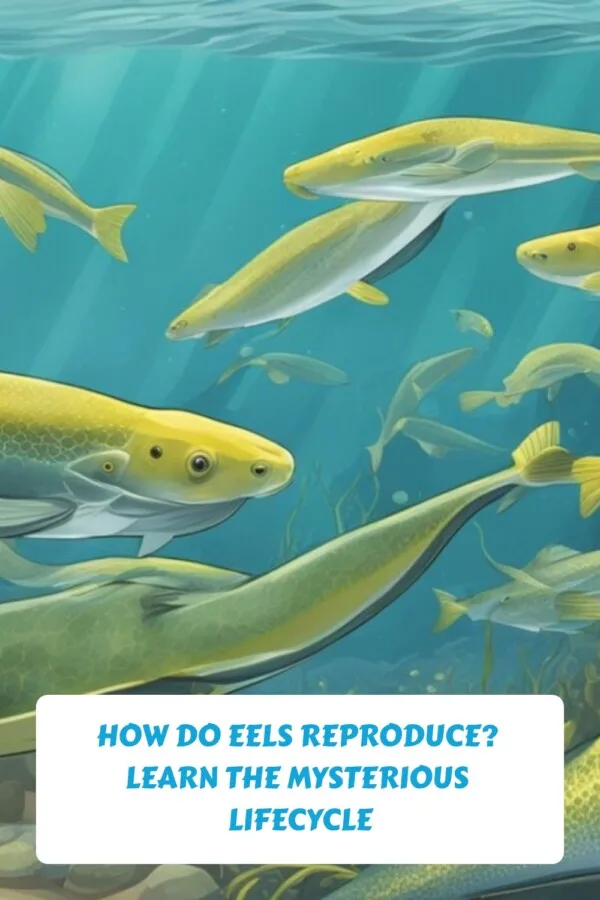Eels, members of the order Anguilliformes, are a group of elongated marine and freshwater fish that have captivated scientists and naturalists for centuries with their complex life cycles and elusive breeding habits. The species Anguilla anguilla, commonly known as the European eel, together with its American and Japanese counterparts, undergoes a remarkable transformation and migration that is critical for reproduction. Despite advances in marine biology, the exact mechanisms of eel reproduction were shrouded in mystery for a long time; however, modern research has shed light on some aspects of their breeding behavior, while other details remain elusive.

The reproductive journey of eels like the Anguillid species begins with a migration from freshwater habitats to specific marine regions, such as the Sargasso Sea for European and American eels, where spawning is believed to take place. The transition from freshwater to saltwater is a pivotal part of their life cycle. Adult eels undergo physical changes to prepare for the oceanic voyage and reproduction once they reach the spawning grounds. Although direct observation in their natural habitat is limited, it is understood that eels likely reproduce through external fertilization, where the female releases eggs and the male releases sperm into the water column.
Key Takeaways
- Eels undergo a significant transformation and migration to reproduce.
- Spawning is presumed to occur in specific marine areas like the Sargasso Sea.
- While exact details are complex, eels engage in external fertilization for reproduction.
How Big Can Eels Get
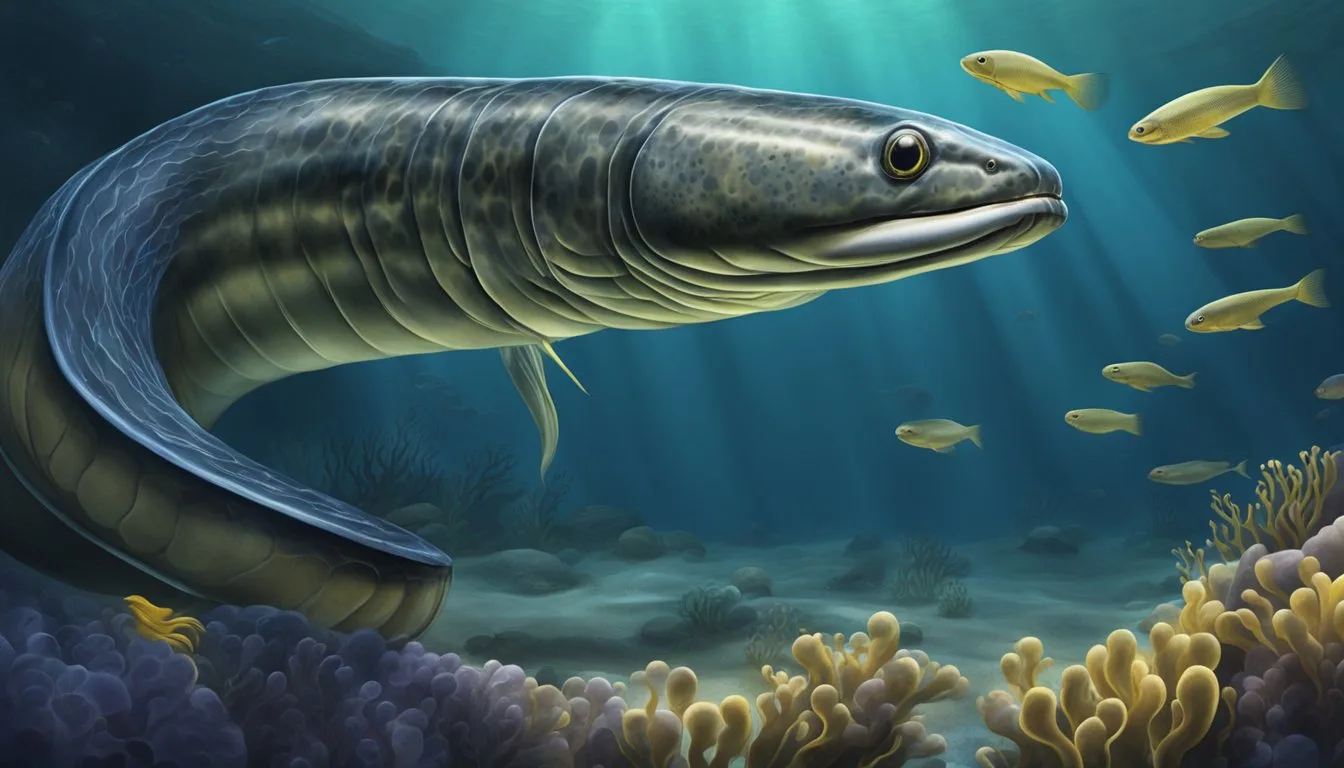
Eel species vary widely in size. They can range from the diminutive 10 cm (4 in) deep-sea eels to the robust giant moray, which may exceed 3 meters (about 10 feet) in length. Specifically, the European eel (Anguilla anguilla), known for its extensive migrations, generally grows up to 1.5 meters (around 5 feet).
Physical Characteristics:
The bodies of eels are elongated and snake-like, and their scaleless skin can feel slippery due to a mucous coating. This slimy layer aids in their movement and serves as protection. Eels lack pelvic fins, and their small pectoral fins are situated right behind their head.
Color and Pigmentation:
Coloration in eels is diverse, reflecting their varied habitats. Many species display a counter-shaded pigmentation, with darker backs and lighter bellies that assist in camouflage from different angles. Their colors can range from drab gray or brown to vibrant greens, yellows, and even patterned hues. Skin pigmentation can also change during different life stages or when preparing for breeding migrations.
Table: Eel Size Comparison
SpeciesAvg. SizeMax. SizeNotable FeaturesEuropean Eel60-80 cm1.5 mLong migrations to Sargasso SeaAmerican Eel60-90 cm1.2 mSimilar migrations to European eelGiant Moray2.5 m> 3 mLargest of the moray eel species
In conclusion, eels can vary significantly in size based on the species, with some reaching impressive lengths. Their physical characteristics, including skin texture, pigmentation, and fin structure, are adapted to their environments and lifestyles.
See Related: Incredibly Cool Sea Creatures to Know
What Do Eels Look Like?

Eels exhibit a remarkable diversity in appearance across various species, such as the European eel (Anguilla anguilla), American eel (Anguilla rostrata), and Japanese eel (Anguilla japonica). Commonly characterized by their elongated, snakelike bodies, eels can have varying skin textures and patterns of pigmentation.
Coloration varies with age and lifecycle stage:
- Glass eels are transparent larvae that gradually gain color.
- Yellow eels have a greenish-brown to yellow-brown color.
- Silver eels develop a distinctive silvery belly and darker back as they mature.
Skin texture also varies:
- Some species have smooth skin, while others possess small scales embedded within it.
- In adult stages, the skin thickens and often becomes slimy, an adaptation aiding their movement in and out of water.
Size can be species-specific:
- American eel females grow larger than males, reaching upwards of a meter.
- European and Japanese eels are comparable, with lengths typically up to 1 to 1.5 meters.
Physical features include:
- A conjoined dorsal and anal fin running lengthily from the middle to the tail.
- In some, pectoral fins are present, but other limbs are absent.
Eels’ body shape and fins contribute to their swimming agility, allowing for forward and backward movement. Their colors and pigmentation serve as camouflage within aquatic environments, assisting in both predation and evasion from predators.
How Do Eels Reproduce?
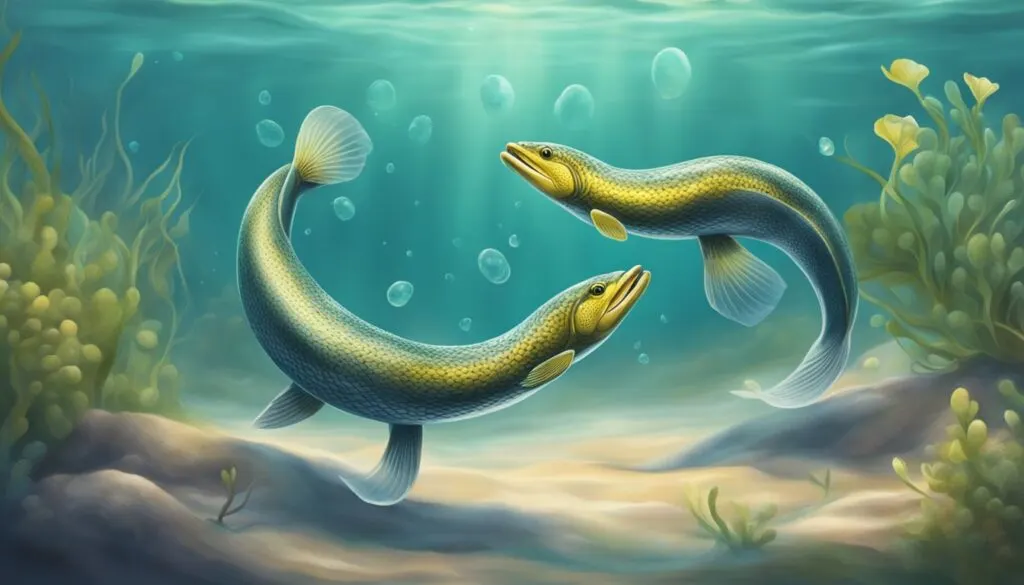
The reproduction of eels remains partially enigmatic, with certain aspects not fully understood. However, scientists have ascertained that eels generally undergo a transformation to reach sexual maturity, which includes changes in body shape, color, and the development of reproductive organs. Eel reproduction typically involves the process of external fertilization.
Spawning Behavior
Most eel species migrate to specific spawning sites to reproduce. Upon reaching sexual maturity, eels’ bodies produce hormones that trigger their migration to these areas. Notably, the European and American eels are believed to spawn in the Sargasso Sea.
Reproductive Anatomy
Inside the eels, the gonads mature as they approach their spawning grounds. Males release sperm, and females release eggs into the water column, a reproductive strategy known as external fertilization.
The fertilized eggs develop into leaf-shaped larvae known as leptocephalus. These larvae drift with ocean currents for extended periods before metamorphosing into glass eels, then elvers, and eventually into adult eels.
Reproductive Cycle
The larval phase significantly differs from their adult form, contributing to the mystique surrounding their life cycle. This stage can last several years, with the leptocephalus larvae undergoing a series of transformations before reaching full maturity. Once mature, eels become part of the reproductive cycle, maintaining the species’ survival. The process of how eels reproduce is intrinsic, ensuring the propagation of their species through a cycle that combines mystery with an evolved adaptation to their aquatic environment.
Where Do Eels Reproduce?
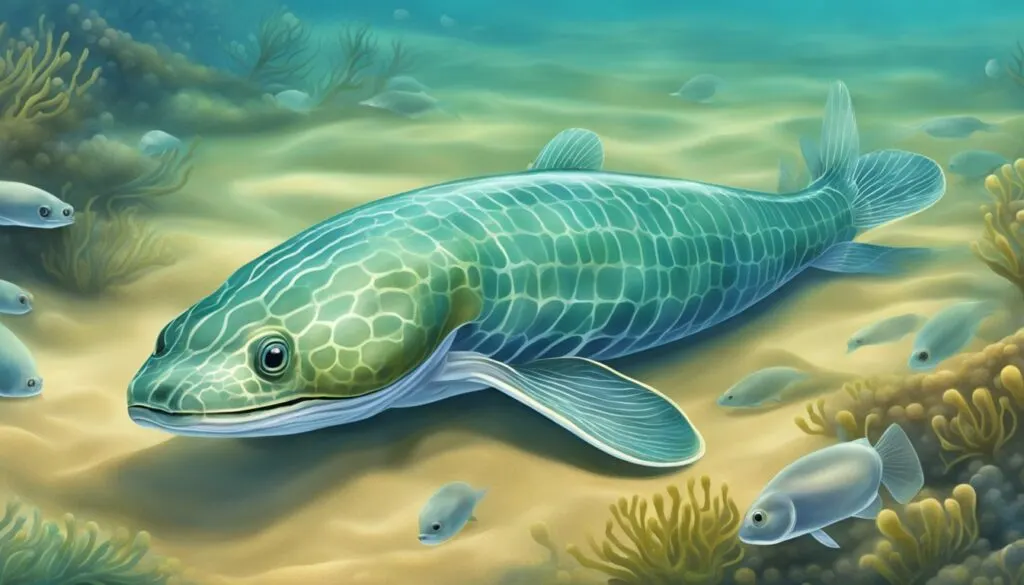
Eels embark on a remarkable migration journey to reproduce, one that has long fascinated scientists. European eels (Anguilla anguilla) and American eels (Anguilla rostrata) converge in the Sargasso Sea, a region of the North Atlantic Ocean. This location is unique due to the Sargasso’s characteristic gyre—a large system of rotating ocean currents—which plays a crucial role in the life cycle of eels.
The exact spawning grounds within the Sargasso Sea are not precisely mapped, but researchers infer that these areas provide the perfect conditions for eel reproduction. The significance of the Sargasso Sea lies in its floating vegetation and the interplay of magnetic fields which are thought to guide eels through their migration. Spawning typically takes place between winter and early spring.
Once in the Sargasso Sea, after a journey that can span thousands of miles from rivers and coasts near Europe and North America, including the area around Bermuda, adult eels rely on external fertilization. They release eggs and sperm into the water, where fertilization occurs.
Upon hatching, eel larvae, known as leptocephali, begin the next phase of their life: the larval stage. Here, the larvae are carried by the Gulf Stream towards their juvenile habitats across the Atlantic. Eel larvae’s pelvic fins are undeveloped, which is unlike those of other fish species that use them for movement. The transformation from the larval stage to their eventual form, as they approach European and American coasts, marks the completion of their breeding cycle.
This particular breeding behavior underscores the eels’ reliance on their unique breeding ground and highlights the intricacies of their life cycle.
See Related: List of Animals That Mate for Life
Eel Life Cycle
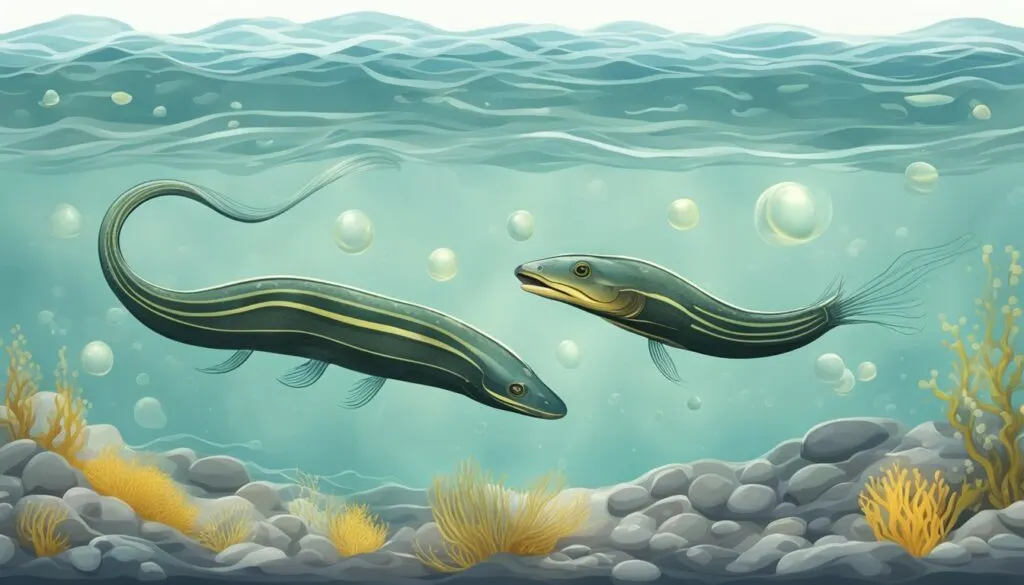
The eel life cycle is complex, involving multiple stages and considerable geographic range. Eels undergo a metamorphosis during their life, with distinct differences in physical characteristics and habitats as they mature.
Glass Eel Stage
After hatching in the Sargasso Sea, the eel larvae, known as leptocephalus, drift on ocean currents towards coastal areas. These larvae transform into a stage called glass eels, characterized by their transparent bodies. Glass eels begin to populate estuaries and the lower reaches of rivers, marking the start of their transition from salt to freshwater environments.
Elver and Yellow Eel Stage
As glass eels develop, they enter the elver stage, gaining pigmentation and becoming more eel-like in appearance. They continue their journey into inland waters, where they grow into yellow eels. This juvenile stage can last several years, during which yellow eels reside in freshwater or brackish waters, contributing to the wild population. They show significant growth before reaching sexual maturity and transforming into silver eels, the final stage before making the long migration back to the Sargasso Sea to participate in spawning and complete their life cycle.
Frequently Asked Questions
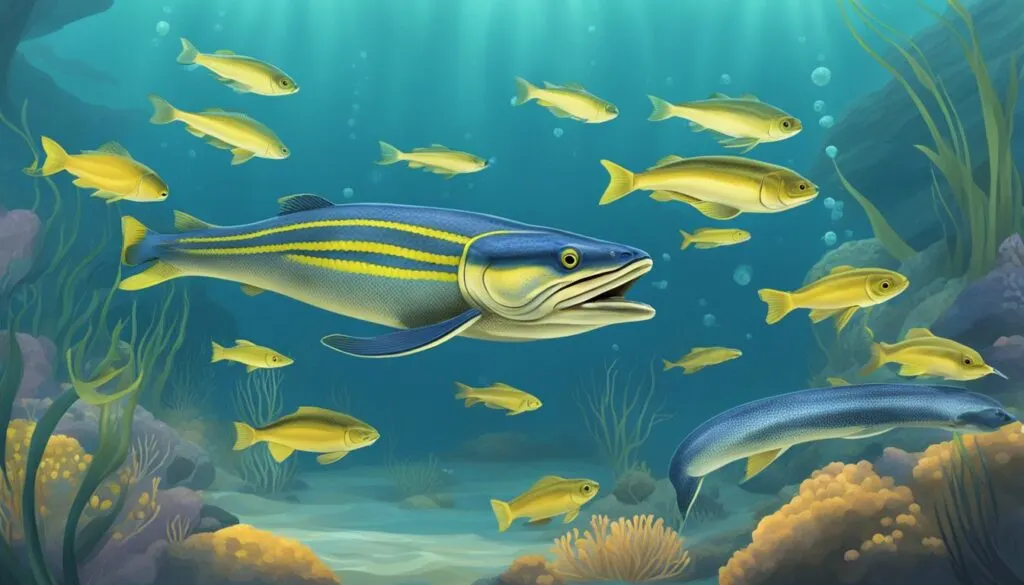
Understanding eel reproduction involves unraveling biological mysteries that have puzzled researchers for centuries. These questions touch on the heart of that enigma.
What are the general steps in the reproductive process of eels?
Eels typically undertake long migrations from their freshwater or coastal habitats to spawn in deep marine waters. The believed method of eel reproduction involves external fertilization, where females release eggs and males release sperm simultaneously into the water.
Why is the breeding behavior of eels still a mystery to scientists?
Despite advancements in marine biology, eel breeding behavior remains elusive due to their spawning in the ocean depths which are difficult to observe. The exact location and method of eel spawning have yet to be fully documented in the wild.
How do different eel species vary in their reproductive methods?
Variations in reproductive methods between eel species are primarily linked to their migratory patterns and spawning locations. Some eels travel thousands of miles to their spawning grounds, while others have shorter migration routes.
Are American eels capable of reproducing in freshwater environments?
American eels are catadromous, meaning they migrate from freshwater rivers to the Atlantic Ocean’s Sargasso Sea to spawn. Their life cycle dictates reproduction in saltwater environments, and there is no evidence of them successfully reproducing in freshwater.
Related Resources:
- These Are Creepy! Different Types of Eels in the World
- Alligator vs Crocodile: Unveiling the Riveting Battles of Reptilian Might
- Snail Diet: What Do Snails Eat and How to Feed Them Properly

